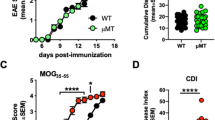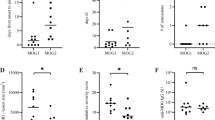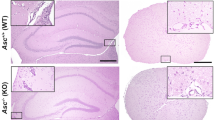Abstract
Several mouse models of multiple sclerosis (MS) are now available. We have established a mouse model, in which ocular infection with a recombinant HSV-1 that expresses murine interleukin (IL)-2 constitutively (HSV-IL-2) causes central nervous system demyelination in different strains of mice. This model differs from most other models, in which it represents a mixture of viral and immune triggers. In the present study, we directly compared MOG35–55, MBP35–47 and PLP190–209 models of experimental autoimmune encephalitis with our HSV-IL-2-induced MS model. Mice with HSV-IL-2- and myelin oligodendrocyte glycoprotein (MOG)-induced demyelinating diseases demonstrated a similar pattern and distribution of demyelination in their brain, spinal cord (SC) and optic nerves (ONs). In contrast, no demyelination was detected in the ONs of myelin basic protein (MBP)- and proteolipid protein (PLP)-injected mice. Interferon-β (IFN-β) injections significantly reduced demyelination in brains of all groups, in the SCs of the MOG and MBP groups, and completely blocked it in the SCs of the PLP and HSV-IL-2 groups as well as in ONs of MOG and HSV-IL-2 groups. In contrast to IFN-β treatment, IL-12p70 protected the HSV-IL-2 group from demyelination, whereas IL-4 was not effective at all in preventing demyelination. MOG-injected mice showed clinical signs of paralysis and disease-related mortality, whereas mice in the other treatment groups did not. Collectively, the results indicate that the HSV-IL-2 model and the MOG model complement each other and, together, provide unique insights into the heterogeneity of human MS.
This is a preview of subscription content, access via your institution
Access options
Subscribe to this journal
Receive 12 print issues and online access
$259.00 per year
only $21.58 per issue
Buy this article
- Purchase on Springer Link
- Instant access to full article PDF
Prices may be subject to local taxes which are calculated during checkout





Similar content being viewed by others
References
Noseworthy JH, Lucchinetti C, Rodriguez M, Weinshenker BG . Multiple sclerosis. N Engl J Med 2000; 343: 938–952.
Hunter SF, Weinshenker BG, Carter JL, Noseworthy JH . Rational clinical immunotherapy for multiple sclerosis. Mayo Clin Proc 1997; 72: 765–780.
Challoner PB, Smith KT, Parker JD, MacLeod DL, Coulter SN, Rose TM et al. Plaque-associated expression of human herpesvirus 6 in multiple sclerosis. Proc Natl Acad Sci USA 1995; 92: 7440–7444.
Friedman JE, Lyons MJ, Cu G, Ablashl DV, Whitman JE, Edgar M et al. The association of the human herpesvirus-6 and MS. Mult Scler 1999; 5: 355–362.
Boman J, Roblin PM, Sundstrom P, Sandstrom M, Hammerschlag MR . Failure to detect Chlamydia pneumoniae in the central nervous system of patients with MS. Neurology 2000; 54: 265.
Martin C, Enbom M, Soderstrom M, Fredrikson S, Dahl H, Lycke J et al. Absence of seven human herpesviruses, including HHV-6, by polymerase chain reaction in CSF and blood from patients with multiple sclerosis and optic neuritis. Acta Neurol Scand 1997; 95: 280–283.
Mirandola P, Stefan A, Brambilla E, Campadelli-Fiume G, Grimaldi LM . Absence of human herpesvirus 6 and 7 from spinal fluid and serum of multiple sclerosis patients. Neurology 1999; 53: 1367–1368.
Gold R, Linington C, Lassmann H . Understanding pathogenesis and therapy of multiple sclerosis via animal models: 70 years of merits and culprits in experimental autoimmune encephalomyelitis research. Brain 2006; 129: 1953–1971.
tHart BA, Hintzen RQ, Laman JD . Multiple sclerosis - a response-to-damage model. Trends Mol Med 2009; 15: 235–244.
Ransohoff RM . Animal models of multiple sclerosis: the good, the bad and the bottom line. Nat Neurosci 2012; 15: 1074–1077.
t Hart BA, Gran B, Weissert R . EAE: imperfect but useful models of multiple sclerosis. Trends Mol Med 2011; 17: 119–125.
Zamvil SS, Steinman L . The T lymphocyte in experimental allergic encephalomyelitis. Annu Rev Immunol 1990; 8: 579–621.
Martin R, McFarland HF, McFarlin DE . Immunological aspects of demyelinating diseases. Annu Rev Immunol 1992; 10: 153–187.
Ferrante P, Omodeo-Zorini E, Caldarelli-Stefano R, Mediati M, Fainardi E, Granieri E et al. Detection of JC virus DNA in cerebrospinal fluid from multiple sclerosis patients. Mult Scler 1998; 4: 49–54.
Morris MM, Dyson H, Baker D, Harbige LS, Fazakerley JK, Amor S . Characterization of the cellular and cytokine response in the central nervous system following Semliki Forest virus infection. J Neuroimmunol 1997; 74: 185–197.
Haider S, Nafziger D, Gutierrez JA, Brar I, Mateo N, Fogle J . Progressive multifocal leukoencephalopathy and idiopathic CD4+lymphocytopenia: a case report and review of reported cases. Clin Infect Dis 2000; 31: E20–E22.
Parsons LM, Webb HE . Identification of immunoglobulin-containing cells in the central nervous system of the mouse following infection with the demyelinating strain of Semliki Forest virus. Br J Exp Pathol 1989; 70: 247–255.
Jacobson S, Shida H, McFarlin DE, Fauci AS, Koenig S . Circulating CD8+ cytotoxic T lymphocytes specific for HTLV-I pX in patients with HTLV-I associated neurological disease. Nature 1990; 348: 245–248.
Haring J, Perlman S . Mouse hepatitis virus. Curr Opin Microbiol 2001; 4: 462–466.
Miller SD, Olson JK, Croxford JL . Multiple pathways to induction of virus-induced autoimmune demyelination: lessons from Theiler's virus infection. J Autoimmun 2001; 16: 219–227.
Osorio Y, La Point SF, Nusinowitz S, Hofman FM, Ghiasi H . CD8+-dependent CNS demyelination following ocular infection of mice with a recombinant HSV-1 expressing murine IL-2. Exp Neurol 2005; 193: 1–18.
Mott KR, Gate D, Zandian M, Allen SJ, Rajasagi NK, Van Rooijen N et al. Macrophage IL-12p70 signaling prevents HSV-1-induced CNS autoimmunity triggered by autoaggressive CD4+ Tregs. Invest Ophthalmol Vis Sci 2011; 52: 2321–2333.
Zandian M, Belisle R, Mott KR, Nusinowitz S, Hofman FM, Ghiasi H . Optic neuritis in different strains of mice by a recombinant HSV-1 expressing murine interleukin-2. Invest Ophthalmol Vis Sci 2009; 50: 3275–3282.
Zandian M, Mott KR, Allen SJ, Chen S, Arditi M, Ghiasi H . IL-2 suppression of IL-12p70 by a a recombinant HSV-1 expressing IL-2 induces T cells auto-reactivity and CNS demyelination. PLoS One 2011; 6: e16820.
Zandian M, Mott KR, Allen SJ, Dumitrascu O, Kuo JZ, Ghiasi H . Use of cytokine immunotherapy to block CNS demyelination induced by a recombinant HSV-1 expressing murine interleukin-2. Gene Therapy 2011; 18: 734–742.
Mott KR, Zandian M, Allen SJ, Ghiasi H . Role of IL-2 and HSV-1 in CNS demyelination in mice. J Virol 2013; 87: 12102–12109.
Fletcher JM, Lalor SJ, Sweeney CM, Tubridy N, Mills KH . T cells in multiple sclerosis and experimental autoimmune encephalomyelitis. Clin Exp Immunol 2010; 162: 1–11.
Hafler DA . Multiple sclerosis. J Clin Invest 2004; 113: 788–794.
Simpson JE, Newcombe J, Cuzner ML, Woodroofe MN . Expression of monocyte chemoattractant protein-1 and other beta- chemokines by resident glia and inflammatory cells in multiple sclerosis lesions. J Neuroimmunol 1998; 84: 238–249.
Li H, Cuzner ML, Newcombe J . Microglia-derived macrophages in early multiple sclerosis plaques. Neuropathol Appl Neurobiol 1996; 22: 207–215.
Windhagen A, Newcombe J, Dangond F, Strand C, Woodroofe MN, Cuzner ML et al. Expression of costimulatory molecules B7-1 (CD80), B7-2 (CD86), and interleukin 12 cytokine in multiple sclerosis lesions. J Exp Med 1995; 182: 1985–1996.
Trotter JL, Clifford DB, McInnis JE, Griffeth RC, Bruns KA, Perlmutter MS et al. Correlation of immunological studies and disease progression in chronic progressive multiple sclerosis. Ann Neurol 1989; 25: 172–178.
Wu GF, Perlman S . Macrophage infiltration, but not apoptosis, is correlated with immune- mediated demyelination following murine infection with a neurotropic coronavirus. J Virol 1999; 73: 8771–8780.
Mori Y, Murakami M, Arima Y, Zhu D, Terayama Y, Komai Y et al. Early pathological alterations of lower lumbar cords detected by ultrahigh-field MRI in a mouse multiple sclerosis model. Int Immunol 2013; 26: 93–101.
Karp CL, van Boxel-Dezaire AH, Byrnes AA, Nagelkerken L . Interferon-beta in multiple sclerosis: altering the balance of interleukin-12 and interleukin-10? Curr Opin Neurol 2001; 14: 361–368.
Gran B, Zhang GX, Yu S, Li J, Chen XH, Ventura ES et al. IL-12p35-deficient mice are susceptible to experimental autoimmune encephalomyelitis: evidence for redundancy in the IL-12 system in the induction of central nervous system autoimmune demyelination. J Immunol 2002; 169: 7104–7110.
Cua DJ, Sherlock J, Chen Y, Murphy CA, Joyce B, Seymour B et al. Interleukin-23 rather than interleukin-12 is the critical cytokine for autoimmune inflammation of the brain. Nature 2003; 421: 744–748.
Vollmer TL, Wynn DR, Alam MS, Valdes J . A phase 2, 24-week, randomized, placebo-controlled, double-blind study examining the efficacy and safety of an anti-interleukin-12 and -23 monoclonal antibody in patients with relapsing-remitting or secondary progressive multiple sclerosis. Mult Scler 2011; 17: 181–191.
Poliani PL, Brok H, Furlan R, Ruffini F, Bergami A, Desina G et al. Delivery to the central nervous system of a nonreplicative herpes simplex type 1 vector engineered with the interleukin 4 gene protects rhesus monkeys from hyperacute autoimmune encephalomyelitis. Hum Gene Therapy 2001; 12: 905–920.
Furlan R, Poliani PL, Marconi PC, Bergami A, Ruffini F, Adorini L et al. Central nervous system gene therapy with interleukin-4 inhibits progression of ongoing relapsing-remitting autoimmune encephalomyelitis in Biozzi AB/H mice. Gene Therapy 2001; 8: 13–19.
Broberg E, Setala N, Roytta M, Salmi A, Eralinna JP, He B et al. Expression of interleukin-4 but not of interleukin-10 from a replicative herpes simplex virus type 1 viral vector precludes experimental allergic encephalomyelitis. Gene Therapy 2001; 8: 769–777.
Kuerten S, Angelov DN . Comparing the CNS morphology and immunobiology of different EAE models in C57BL/6 mice - a step towards understanding the complexity of multiple sclerosis. Ann Anatomy 2008; 190: 1–15.
Soderstrom M, Ya-Ping J, Hillert J, Link H . Optic neuritis: prognosis for multiple sclerosis from MRI, CSF, and HLA findings. Neurology 1998; 50: 708–714.
Sandberg-Wollheim M, Bynke H, Cronqvist S, Holtas S, Platz P, Ryder LP . A long-term prospective study of optic neuritis: evaluation of risk factors. Ann Neurol 1990; 27: 386–393.
Rodriguez M, Siva A, Cross SA, O'Brien PC, Kurland LT . Optic neuritis: a population-based study in Olmsted County, Minnesota. Neurology 1995; 45: 244–250.
O'Riordan JI, Losseff NA, Phatouros C, Thompson AJ, Moseley IF, MacManus DG et al. Asymptomatic spinal cord lesions in clinically isolated optic nerve, brain stem, and spinal cord syndromes suggestive of demyelination. J Neurol Neurosurg Psychiatry 1998; 64: 353–357.
Ghezzi A, Martinelli V, Torri V, Zaffaroni M, Rodegher M, Comi G et al. Long-term follow-up of isolated optic neuritis: the risk of developing multiple sclerosis, its outcome, and the prognostic role of paraclinical tests. J Neurol 1999; 246: 770–775.
Optic Neuritis Study G. Multiple sclerosis risk after optic neuritis: final optic neuritis treatment trial follow-up. Arch Neurol 2008; 65: 727–732.
Hardmeier M, Hatz F, Naegelin Y, Hight D, Schindler C, Kappos L et al. Improved characterization of visual evoked potentials in multiple sclerosis by topographic analysis. Brain Topogr 2013; 27: 318–327.
Steinman L . Myelin-specific CD8 T cells in the pathogenesis of experimental allergic encephalitis and multiple sclerosis. J Exp Med 2001; 194: F27–F30.
Traugott U, Reinherz EL, Raine CS . Multiple sclerosis. Distribution of T cells, T cell subsets and Ia- positive macrophages in lesions of different ages. J Neuroimmunol 1983; 4: 201–221.
Pannemans K, Broux B, Goris A, Dubois B, Broekmans T, Van Wijmeersch B et al. HLA-E restricted CD8+ T cell subsets are phenotypically altered in multiple sclerosis patients. Mult Scler 2013; e-pub ahead of print 21 October 2013.
Wu GF, Dandekar AA, Pewe L, Perlman S . CD4 and CD8 T cells have redundant but not identical roles in virus- induced demyelination. J Immunol 2000; 165: 2278–2286.
Zamvil S, Nelson P, Trotter J, Mitchell D, Knobler R, Fritz R et al. T-cell clones specific for myelin basic protein induce chronic relapsing paralysis and demyelination. Nature 1985; 317: 355–358.
Prineas JW, Wright RG . Macrophages, lymphocytes, and plasma cells in the perivascular compartment in chronic multiple sclerosis. Lab Invest 1978; 38: 409–421.
Tran EH, Hoekstra K, van Rooijen N, Dijkstra CD, Owens T . Immune invasion of the central nervous system parenchyma and experimental allergic encephalomyelitis, but not leukocyte extravasation from blood, are prevented in macrophage-depleted mice. J Immunol 1998; 161: 3767–3775.
D'Andrea A, Rengaraju M, Valiante NM, Chehimi J, Kubin M, Aste M et al. Production of natural killer cell stimulatory factor (interleukin 12) by peripheral blood mononuclear cells. J Exp Med 1992; 176: 1387–1398.
Schwarz T . Interleukin-12 and its role in cutaneous sensitization. Res Immunol 1995; 146: 494–499.
Paul WE, Seder RA . Lymphocyte responses and cytokines. Cell 1994; 76: 241–251.
Le Gros G, Ben-Sasson SZ, Seder R, Finkelman FD, Paul WE . Generation of interleukin 4 (IL-4)-producing cells in vivo and in vitro: IL-2 and IL-4 are required for in vitro generation of IL-4-producing cells. J Exp Med 1990; 172: 921–929.
Koehler NK, Genain CP, Giesser B, Hauser SL . The human T cell response to myelin oligodendrocyte glycoprotein: a multiple sclerosis family-based study. J Immunol 2002; 168: 5920–5927.
Kahl KG, Kruse N, Toyka KV, Rieckmann P . Serial analysis of cytokine mRNA profiles in whole blood samples from patients with early multiple sclerosis. J Neurol Sci 2002; 200: 53–55.
Racke MK, Burnett D, Pak SH, Albert PS, Cannella B, Raine CS et al. Retinoid treatment of experimental allergic encephalomyelitis. IL-4 production correlates ith improved disease course. J Immunol 1995; 154: 450–458.
Plosker GL . Interferon-beta-1b: a review of its use in multiple sclerosis. CNS Drugs 2011; 25: 67–88.
Ghiasi H, Osorio Y, Perng GC, Nesburn AB, Wechsler SL . Overexpression of interleukin-2 by a recombinant herpes simplex virus type 1 attenuates pathogenicity and enhances antiviral immunity. J Virol 2002; 76: 9069–9078.
Ghiasi H, Osorio Y, Perng GC, Nesburn AB, Wechsler SL . Recombinant herpes simplex virus type 1 expressing murine interleukin-4 is less virulent than wild-type virus in mice. J Virol 2001; 75: 9029–9036.
Glorioso JC, Bender MA, Goins WF, Fink DJ, DeLuca N . HSV as a gene transfer vector for the nervous system. Mol Biotechnol 1995; 4: 87–99.
Zwaagstra JC, Ghiasi H, Slanina SM, Nesburn AB, Wheatley SC, Lillycrop K et al. Activity of herpes simplex virus type 1 latency-associated transcript (LAT) promoter in neuron-derived cells: evidence for neuron specificity and for a large LAT transcript. J Virol 1990; 64: 5019–5028.
Parker JN, Gillespie GY, Love CE, Randall S, Whitley RJ, Markert JM . Engineered herpes simplex virus expressing IL-12 in the treatment of experimental murine brain tumors. Proc Natl Acad Sci USA 2000; 97: 2208–2213.
Hirata S, Senju S, Matsuyoshi H, Fukuma D, Uemura Y, Nishimura Y . Prevention of experimental autoimmune encephalomyelitis by transfer of embryonic stem cell-derived dendritic cells expressing myelin oligodendrocyte glycoprotein peptide along with TRAIL or programmed death-1 ligand. J Immunol 2005; 174: 1888–1897.
Pham H, Doerrbecker J, Ramp AA, D'Souza CS, Gorasia DG, Purcell AW et al. Experimental autoimmune encephalomyelitis (EAE) IN C57Bl/6 mice is not associated with astrogliosis. J Neuroimmunol 2011; 232: 51–62.
Ghiasi H, Wechsler SL, Kaiwar R, Nesburn AB, Hofman FM . Local expression of tumor necrosis factor alpha and interleukin-2 correlates with protection against corneal scarring after ocular challenge of vaccinated mice with herpes simplex virus type 1. J Virol 1995; 69: 334–340.
Acknowledgements
This work was supported by Public Health Service grants EY15557, EY13615 and AI093941. We thank Dr James M Markert of the Division of Neurosurgery, Department of Surgery, University of Alabama at Birmingham, for providing the M002 (HSV-IL-12p70) virus.
Author information
Authors and Affiliations
Corresponding author
Ethics declarations
Competing interests
The authors declare no conflict of interest.
Additional information
Supplementary Information accompanies this paper on Gene Therapy website
Supplementary information
Rights and permissions
About this article
Cite this article
Dumitrascu, O., Mott, K. & Ghiasi, H. A comparative study of experimental mouse models of central nervous system demyelination. Gene Ther 21, 599–608 (2014). https://doi.org/10.1038/gt.2014.33
Received:
Revised:
Accepted:
Published:
Issue Date:
DOI: https://doi.org/10.1038/gt.2014.33
This article is cited by
-
Attenuated phenotypes and analysis of a herpes simplex virus 1 strain with partial deletion of the UL7, UL41 and LAT genes
Virologica Sinica (2017)
-
The mutated tegument protein UL7 attenuates the virulence of herpes simplex virus 1 by reducing the modulation of α-4 gene transcription
Virology Journal (2016)



